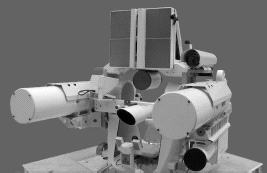|
Tracking / Ranging Radar |
||||
|
|
The RR-2100 Ranging
Radar is an X-band Multiple Frequency continuous wave radar designed
to be mounted on optical platforms. The purpose of the RR-2100 is to
acquire and track moving targets with very high precision and
deliver real-time range and guidance data at high rate to the
optical platform. The system measures directly in real-time:
|
|||
|
The range, angles and velocity measurements are based entirely on spectrum analysis and digital signal processing. This enables the system to measure all types of objects:
The system uses the X-band frequency in order to ensure:
The Multiple Frequency continuous wave Doppler radar technique gives the following advantages:
|
||||
|
The RR-2100 system consists of a MFDR-2100 Multi Frequency Doppler Radar antenna, an RP-2100 Range Processor and a DC power supply. The RP-2100 incorporates two RS-422/RS-232 high speed interfaces for real time data to the optical platform and/or commands from the control panel or Weibel supplied instrumentation controller. The MFDR antennas have a variable beam width from 10° x 10° to e.g. 2.5° x 5° with automatic or manual switching. The unique built-in self calibrating feature includes both the velocity measurement and the monopulse error phase measurement and ensures reliable and accurate results. The software package for the system is constantly developed and improved to meet new requirements from our customers and to incorporate new features. The new versions of the software are made available to all customers free of charge. The purpose of the Tracking Radar System is to acquire and track moving targets with very high precision and deliver real-time range and guidance data at a high rate to the optical platform. The system measures slant range, azimuth and elevation angles, and radial velocity directly in real-time. The range, angles and velocity measurement are based entirely on spectrum analysis and digital signal processing. The Weibel Monopulse Doppler Tracking Radar System is a portable X-band CW radar system consisting of a radar antenna, azimuth and elevation tracking controller and Doppler analyzer. Transmitting and receiving antennas are micro strip array antennas that are controlled from the instrumentation controller using an RS-422 serial interface. The tracking system is an active real time tracking system measuring radial velocity and azimuth and elevation angles to the projectile. The angle measurement is based on monopulse angle discrimination technique. High speed digital signal processing carries out the calculation of the direction to the target. The tracking system is based entirely on digital data acquisition, storing and processing. The velocity, range and angle measurements are based on spectrum analysis and digital signal processing only. This enables the system to measure on all types of moving targets. The system has a variable beam width from 10 degrees x 10 degrees to 1.25 degrees x 2.5 degrees with automatic or manual switching. The system is able to measure both going and coming targets. The unique built-in self-calibrating feature includes both the velocity and the monopulse error phase, and ensures reliable and accurate results. |
||||
|
KEY FEATURES
|
||||
|
Technical Highlights The system is designed to withstand shock, dust, sand, humidity, rain and salty air. The system is based on multiple frequency continuous wave Doppler radar technology giving real-time velocity and range data. The system uses X-band (10 GHz) frequencies for optimum range performance and position accuracy under all weather conditions. The system has high velocity and angle accuracy and a long measuring range due to unique velocity self calibration technology. The system never needs to be calibrated, built-in I/Q calibration generator, ensures that the monopulse error signals are calibrated. High transmitting frequency based on extremely stable phased-locked oscillator (PLO) Low receiver noise figure - 2.0 dB Variable sampling rate and anti aliasing filter settings Variable and adaptive Fast Fourier Transformation (FFT) size from 32 samples to 16 Ksamples The system includes an adaptive opening angle feature variable from 10E x 10E to 1.5° x 5E. This ensures:
|
||||
|
System Overview The RR-2100 system consists of a Multi Frequency Doppler Radar (MFDR) antenna, an RP-2100 Range Processor, a DC power supply and an optional instrumentation controller with peripherals (laser printer and optical disk). The MFDR-2100 antenna is mounted on the Optical Tracking Platform (OTP) in a location where there is no interference with the optics. The antenna can be supplied in one unit or in separate transmitter and receiver units depending on platform layout. The antenna can also be supplied with higher gain and higher output power for increased performance. The RP-2100 Range Processor and power supply can be mounted either behind the antenna or in the base of the Optical Tracking Platform. The entire system is controlled from the instrumentation controller or a customized control panel. |
||||
|
TRACKING RADAR GENERAL SPECIFICATIONS
Accuracy in 20 km, RCS = 1m2 Range 0.03 m Elevation 0.8 mrad Azimuth 1.7 mrad Velocity 0.005% Antenna Transmitter type Multiple Frequency CW Frequency X-band, solid state PLO RF bandwidth 10 MHz Output power 30 W Antenna gain 34 dB Beam width 10° x 10° to 5° x 2.5° Noise figure 2 dB Receiver sensitivity -162 dBm, BW=10 Hz Receiver type Monopulse I/Q with AGC No. of receivers 8 Dynamic range 160 dB, BW=10 Hz Output to processor Max 12 Vp-p, 0-250 kHz Dimension 750x750x50mm or 2 units of 750x350x50 mm Weight 35kg or 2 units of 17kg Processor & Power Supply Input from antenna Differential Data output RS-232c or RS-422 Baud rate 1200 to 500,000 Output rate Up to 100 Hz Data protocol Customer specified Power supply 110 or 220VAC 50/60 Hz Power consumption 500 watts Dimensions 2 pieces – 19" rack 170mm high Environmental Humidity 0 to 100% Operating temperature -20° C to +55°C Storage temperature -40° C to +65°C |
||||
|
Photo-Sonics, Inc. 818-842-2141 (ph - switchboard paging) 818-842-2610 (fax) mail@photosonics.com |
||||
| <back to top> | ||||
|
© 2019 Photo-Sonics, Inc. |
||||

